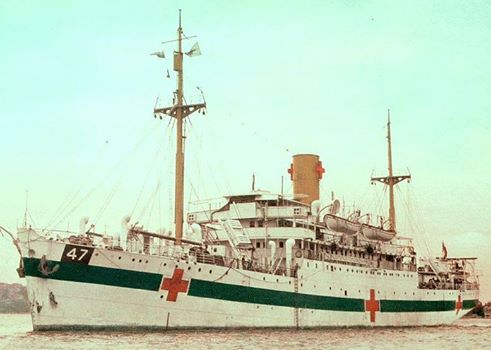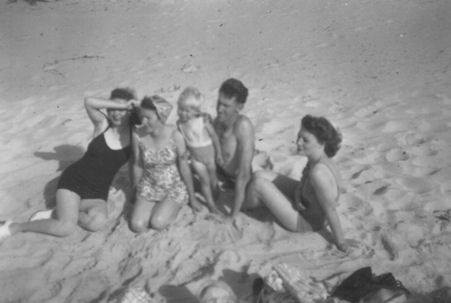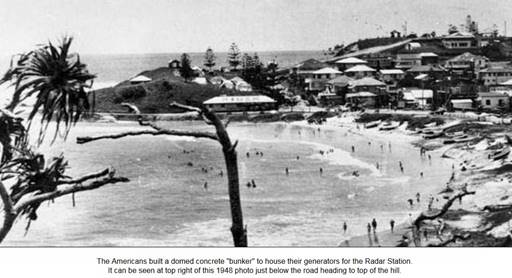COOLANGATTA
My arrival at Coolangatta did not go well. It was dark winter's evening and I was tired from sitting up all night in the train, cold and hungry, when I was dropped off the bus at the Post Office. There was no one there to pick me up and I waited for about 30 minutes. I was really annoyed and went to a shop over the road and the owner kindly let me use his phone. I thought I was speaking to a switchboard operator and let her know my thoughts on my predicament. To my surprise, she took it personally, was very 'snappy' with me and hung up.
A driver in a utility arrived about 10 minutes later. He was a kindly fellow and advised me that there was no switch board or switch girl and I had spoken to the WAAAF Officer. I was warned to be very careful with her, as she was a difficult person and she was very upset with me over the telephone call. I was dropped off at a private home on the road opposite the station and that was the WAAAF 'Barracks'. I cannot remember the number of girls there but it was no more than eight and may have been less. It was unfortunate that the Officer shared this accommodation.
I had no idea that it was such a small Unit, probably no more than about 25 people and again it may have been less. It occupied what had been a cafe/restaurant and other buildings on Point Danger. [I can only remember the surnames of four people and because I had other interests, I did not spend much time on the Unit unless I was at work, so this history is lacking a lot of detail.]
The Officer, I will call Madame, was in my opinion, not a pleasant person but I won't go into details. She was bristling with anger at me, as I was shown around. I soon found out that if she woke up in the morning and was 'tra-la-la ing' some song, the morning at least would be OK. If she was thumping around like a baby elephant, it was to be a day of walking on eggshells and trying to keep out of her way. I had to work near her and was constantly on alert.
***
I cannot remember the leave arrangements for days off but most of the other girls had nowhere special to go and usually slept in and, hard to believe, most then went back to work later. I was therefore even more unpopular with Madame because I made myself scarce.
***
I was lucky that I had friends at Southport (introduced to me by my Father's sister, who had stayed with them), where I stayed when I was on leave overnight. The mother of a friend who lived at Tugun (near Coolangatta), made me welcome there as well.
One time, some of these friends spent time at Southport beach with me for a swim and picnic. I was not fond of the sun, so tried not to get burnt on that day. Below, is the only photo that I have of my time at the Radar Unit. Rene is on the left, her husband is the fellow there and I am on the right. I can't remember the other lady or child.
Rene and another lady (Olive - who was pregnant) were wives of Troopers in the 2/4th Armoured Regiment and the third was the partner of an American and she too was pregnant. I learnt after the war, that the latter was 'dumped' by the father of their son and had a wife in USA.
***
A couple of girls told me some news about some happenings at the Radar Station on the sinking of the hospital ship 'Centaur'. I believed them because they were visibly upset during the talk. The time of day or night, I don't remember it being mentioned. The crew on duty at the time plotted what they believed was a submarine and reported it to Naval HQ in Brisbane. They were assured that there was no submarine in the area. They checked again and it was still there, so they woke the C.O. and he agreed with them and he then also contacted the Navy. Their warnings were ignored. Their consternation, shock and anger when they heard of the sinking and the dreadful loss of life brought most of them to tears. I know it is not necessarily only RAAF History but the RAAF ran this Radar Unit. I have no way of verifying these reports about the sinking but if true, the Navy should have had a lot of questions to answer.
***
Further information came to light:
 This photo and data by courtesy of Wynnum Manly Historical Incís.
This photo and data by courtesy of Wynnum Manly Historical Incís.The ship Centaur was a Scottish built vessel launched in 1924. In January 1943. She was handed over to the Australian military for conversion to a hospital ship. On 14 May 1943 she was attacked and sunk by a Japanese submarine off the east coast of Australia. The sighting by the WAAAF operators of No 23 Radar Station at Lytton that tragic night were not heeded. Jean Renew, an operator on duty that night, says in her poem the Naval authorities did not heed their report saying “No Allied in this area and we’re too far from Japan”.
The wreck was not found until 20 December 2009.
***
I was stationed on 51 Radar Unit (in August 1944) and was under the impression that was the Unit that reported the sighting. So, I can only guess that perhaps one or more of the operators had been posted from No. 23 to No. 51 or those who told me of the events, were repeating stories that they had heard.
Years later, when I was working in Veteran’s Affairs, a sister who had served in the Middle East, told me that as a result of that sinking, a special Daily Routine Order was issued, for all women in the Army. This stated that if they did not wear pyjamas to bed, then they must always have underpants under their night-dresses. I understand that one sister who was saved, was without underclothes when rescued and the Army did not want that to happen again. I believe that she used her nightdress to bandage wounds of some wounded men who survived.
***
I met my future husband Trooper Leo Clarke at Coolangatta. He was in the 1st Armoured Regiment and it was training at Southport, before embarkation. He asked me to join him at a dance there and I did this many times. One of the ladies (Rene) at Southport, went with me and was a great chaperone when Leo accompanied us home. I have no recollection of the proposal for marriage that Leo made but we did talk about getting married, if possible, before he was posted overseas. He was the first 'serious' boyfriend that I had and I was so happy. All other dates previously had been casual outings or in groups.
***
I read the following information about a spy in 'The WAAAF Book' (edited by Clare Stevenson and Honor Darling). This probably occurred before I was sent there but as it was a 'secret' event at Coolangatta, I would not have heard about it anyway. So far, it is the only reference I have found naming that particular unit.
One of the girls was dating an American, who turned out to be a spy. His many questions prompted her to report to her CO. It was arranged for her to meet him in a park with many secret service men hiding nearby and then he was arrested. He was returned to the U.S.A. and punished there.
***
I went to some of the local dances and met a soldier I knew at Nowra. He was a moody, sad fellow and I felt sorry for him. I also met Joan, a friend from Nowra, who was stationed not far away. Another two people from my past were briefly in Coolangatta. One was the teller from the bank, where I deposited money for Sydney Towel Supply in civilian life (now an ordinary soldier) and the other was Miss Weidersen (now an Army Officer) who had been my English and History teacher at my High School.
***
As I never knew what was happening at the Radar Unit, life there was rather dull and uneventful. I had very few visitors coming and going to my lonely 'office' and spent as much time as I could elsewhere. I never realised how lucky I was at Nowra to have a proper office. My desk here was on a large veranda, not far from Madame, so life was not happy and I was the only Clerk Stores on the Unit.
***
The last time I had trouble with orders was at Coolangatta. The WAAAF Section Officer (a nasty type) ordered me to sign for something I had never seen. I asked where it was, so I could sight it. On being informed it was in the Radar Hut, a place I was forbidden to enter, I told her I could not sign. I did not at the time, realise she should never have given it, as it was against orders to do so, under the circumstances. She ordered me again and I firmly refused and in a temper she thumped the table and everything rattled on it. I was angry and I thumped the table too with the same result and said "No'. She stormed off to report me to the Commanding Officer.
Sometime later, I was told to report to him. He was tall middle-aged, kindly man and asked me to sit down and tell him what happened. He knew very well the order should never have been given. I did think I would be in trouble for being disrespectful but that did not happen. He listened quietly and told me he would sort things out. He then asked me what it was like sharing our house with our WAAAF Officer. Did I have a tale of complaints for him! He said not to worry and once again he would sort it out. He evidently told the Section Officer that it was not right for her to be housed with us and he arranged for part of the verandah to be partitioned off and told her to order a bed and curtains etc. She was over the moon at this attention but did not have much time to enjoy it, as she was posted soon after. The Transport Driver (a Cpl.) told me that he had confronted her and warned her that if I got into any trouble, he would report an incident when she struck a girl on the head. The girl fell, hit a log and was knocked unconscious. Why that was not acted on at the time, I have no idea.
***
The third occasion I had a 'flip' was when I was given the opportunity to get a 'lift' in a Beaufort from Coolangatta Airport, Qld. to Camden, NSW, when going on leave. On that occasion, the pilot 'buzzed' most of the lighthouses on the way down. (flew around them or very close) and that really scared me. It took longer to get from Camden Base to Sydney than it took for the flight down. That RAAF station had no WAAAF there, so when I alighted, someone walked ahead of me yelling out 'WAAAF coming'. Depending on the circumstances, hut doors were either banging shut or opening to see me.
When in Sydney in 1945 after the flight from Coolangatta, I visited a Club?? in George Street in Sydney with a friend from Nowra. It was a place where Servicewomen could stay overnight, store luggage, have meals, leave messages and collect mail. My notes now seem hazy but it was for only over a 48 hour period. My memory of it was that it was sponsored by the Australian Women's Weekly and I am positive it was housed in the old David Jones Building Cnr. George, Barrack Streets and King Streets. Long detailed searching on Google has left me confused, as I am not able to verify all these details except for the last sentence in the following paragraphs on the history of the store. No mention of the Australian Women's Weekly.
"To mark David Jones’s 100th anniversary in 1938, a store on Market St was opened by the then prime minister, Billy Hughes. World War II broke out in 1939 and the store was occupied by the Ministry of Munitions. Trading continued despite rationing, hard times and staff joining the armed forces. Part of the George St store was also converted into a club for war service personnel."
***
I was one of the people who had to perform Kitchen Duties when the cook or his offsider had a day off. There was nothing on my duties list as a Clerk Stores about these chores but I had no choice. This work was the hardest and most tiring of anything I had ever carried out. I don't remember peeling vegetables, though I may have done so but clearing tables, getting rid of rubbish, washing and drying dishes, cutlery and pots and pans, wiping down tables and chairs and mopping floors filled the day. Sometimes, I helped to prepare the sweets for meals. Work started very early in the morning and did not finish until about 9 pm, with only short breaks. I did like the fact that I could have 2nd helpings of some foods, particularly baked potatoes and the sweets.
The WAAAF also had to 'fill in' as the duty Canteen Officers on a rotational basis but this was pleasant, as we were able to have short chats to others on the Unit. We did have a good supply of items not available to civilians.
***
I had a bad bout of influenza or bronchitis, after we were moved from the house opposite the Unit to a building near the Radar Station on Point Danger. I was well cared for by a kindly Sick Quarter Attendant but did not see a Doctor. By that time, Madame had been posted elsewhere and I was partly responsible for that action. When I was almost over that bout of illness, the new Madame allowed Leo to come and visit me under her watchful eyes.
***
This Madame was liked by all of us, as she had our welfare as a priority. On very hot days, she allowed us a short 'time off' in the middle of the day (in the blazing sun) to go down to the beach for a quick swim and a bit of a laze on the beach. I never stayed long, as I did not like getting burnt. After that, we could have a rest, then return to duty, working till late in the evening. I feel the visits were the cause of my many skin cancers that I have had in the years since then, as I was not much of a beach person in my younger days. She never realised the danger of the sun on our bodies. Madame checked the kitchen carefully for cleanliness and ensured that our food was well cooked and tasty. I thought she was a great officer and working near her was a pleasant experience.
***
We all wore our summer uniforms here and paid to have them washed, starched and ironed. A 30-40 year old woman, who lived near the unit with her elderly mother, laundered them for us and did a very professional job but we had to bear the cost for this ourselves. She led a very wild life and dragged out unpleasant photos of her boyfriends. She seemed to prefer American Negroes to our service personnel. I would make excuses, when she brought these out again and got away as quickly as I could.
***
I ‘hitched’ rides at various times to Southport and Tugun (mostly in American jeeps) and now realise how lucky I was. I did not have the slightest notion of the risks I was taking but I never had any trouble. One of the men on our unit, was a decent person but I thought he was a bit of a ‘drip’. He told me he was going back to University after the war, to finish his Medical Degree. I told him jokingly that he ‘would not make a doctor’s bootlace’ and he just laughed. How wrong I was! I found out that he did become a medical practitioner in Sydney.
***
One night when I was walking up the hill to the Unit, I was 'ambushed' by a large American negro. I don't remember him grabbing me or what he said but it was very dark and I was really scared. The road here was very wide with trees in the middle and no one was close. This road divided Coolangatta from Tweed Heads. I don't remember either what I said to him but he did not stop me walking away, as fast as my shaking legs could go.
***
While researching photographs, I found this scene. I was not aware of any American Unit there and never saw any of their soldiers on our Unit or nearby. I did see a few men in the shopping areas occasionally. The data here was a great surprise to me. The beach in this photo looks very crowded and does not look like the one I remember and the scene does not jog any memories, except the tall structure at the top right could be the lighthouse.
***
This ends my life here and after 6 months I was posted to Brisbane, where I only stayed for about two weeks.
NEXT>>











